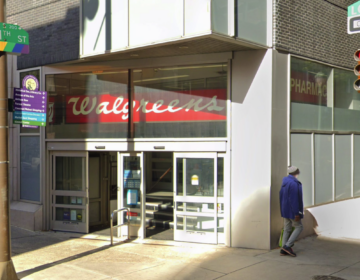Queen Lane Apartments tower can’t face implosion until spring at the earliest

A view inside Thursday's meeting regarding the Queen Lane Apartments demolition plan. (Aaron Moselle/WHYY)
An official with the Philadelphia Housing Authority said Thursday that if the Queen Lane Apartments are to be demolished, it would not happen before spring.
The 16-story high-rise in Germantown was shuttered two years ago to make way for a new 55-unit low-density development.
Initial plans called for a demolition, but the delay has led to talk about a potential renovation of the existing property. At Thursday’s meeting, the former option was the focus of conversation.
Demolition details
A mandatory historical-review process, which centers on a colonial-era burial ground — or Potter’s Field — beneath the site, is winding down. However, it will not be completed in time to properly prepare for the tower’s implosion.
“There’s no way [we will be ready],” said Michael Johns, PHA’s acting deputy executive director for operations, following a morning meeting at the U.S. Department of Urban Housing and Development’s local office in Center City.
Johns said preparation, which includes removing windows and other materials from the building, typically takes three months.
Guidelines set by the city’s Office of Emergency Management prohibit implosion demolitions — in which a building is rigged to collapse on itself — between Dec. 16 and March 1.
Possible sub-freezing temperatures during that stretch are a major concern as contractors usually water down a site to cut down on dust.
Paperwork pending
A programmatic agreement is one of the final steps before the historical review process, called a Section 106 Agreement, can come to a close.
The legal document maps out what actions will be taken going forward if any historic resources are found either during additional archaeological digs, during demolition or construction.
Once the agreement is finalized, PHA can start doing preliminary foundation tests which will determine what type of foundation will be used and, more importantly, how far below ground it needs to sit.
In March, archaeologists revealed the results of an excavation meant to definitely determine the boundaries of the burial ground, known as a Potter’s Field.
While no human remains were discovered outside of the historic boundaries of the roughly two-acre area, which PHA has vowed not to build upon, some “potentially significant” archaeological deposits may exist at the site.
A series of 17th and 18th century homes were demolished at the site in the 1950s.
“We know there are archaeological deposits that are on the block,” said Kenneth Basalik, the project’s principal investigative archaeologist. “But until PHA actually does the core borings and the percolation test, we don’t know how deep their impacts are going to go.
“On some parts of the property, there is three, four and, in some cases, six or seven feet of fill before you have the potential of finding archaeological deposits there.”
And, there could be more.
Historical impact
If previously unknown historical resources are discovered before construction in the former backyards or privies of the site’s historic homes, further archaeological analysis could be necessary.
PHA won’t have to do any more digs if archaeological deposits sit below the foundation.
Johns said three feet is standard. He added that he hopes that’s what’s needed at Queen Lane.
“If we find things that are so significant and so costly that it affects our ability to complete the project, then that is a fundamental question of how we complete the project,” said Johns.
The project’s $24 million pricetag includes the cost of demolition and construction. To date, PHA has spent roughly $1.2 million.
What’s next?
Comments from four signatory agencies — HUD, PHA, the Advisory Council on Historic Preservation and Pennsylvania State Historic Preservation Office — and a host of concurring parties must be submitted by Sept. 23.
HUD officials will then consider those comments as it finalizes agreement details. The programmatic agreement becomes legally binding with the approval of the four signatory agencies.
Division Director Monica Hawkins said HUD anticipates the Section 106 Agreement to be finalized 30 to 60 days after the programmatic agreement is executed.
“We see the light at the end of the tunnel,” she said.
Once the Section 106 Agreement is completed, HUD can move forward with giving the project environmental clearance. That paves the way for demolition clearance, which enables PHA to secure the necessary permits from the city.
Demolition not a certaintly
If the tower will be demolished at all, however, is still a bit up in the air.
Earlier this month, PHA’s Executive Director Kelvin Jeremiah told NewsWorks that the agency is now “seriously considering” rehabbing the existing building instead of moving forward with the new development.
Jeremiah said the option, which some residents adamantly oppose, would be cheaper and take less time for residents to move in.
It would cost roughly $20 million to rehab the existing tower.
A decision one way or the other is expected in October.
Following Thursday’s meeting, Johns simply said that he is “hopeful” the new development will be built.
WHYY is your source for fact-based, in-depth journalism and information. As a nonprofit organization, we rely on financial support from readers like you. Please give today.




